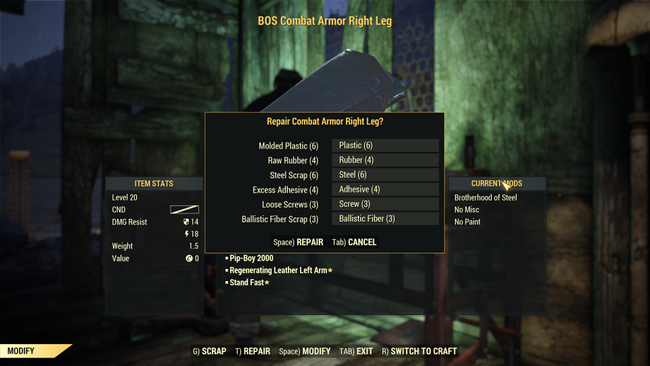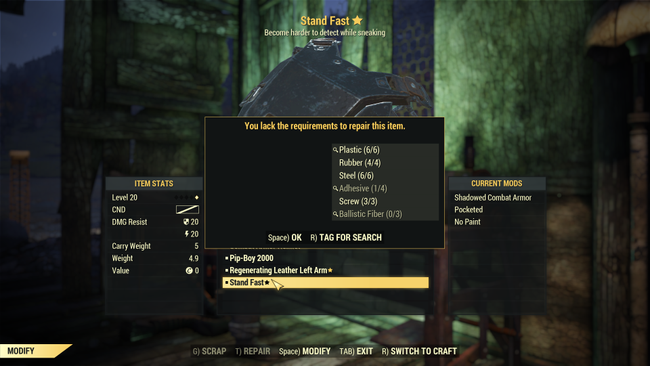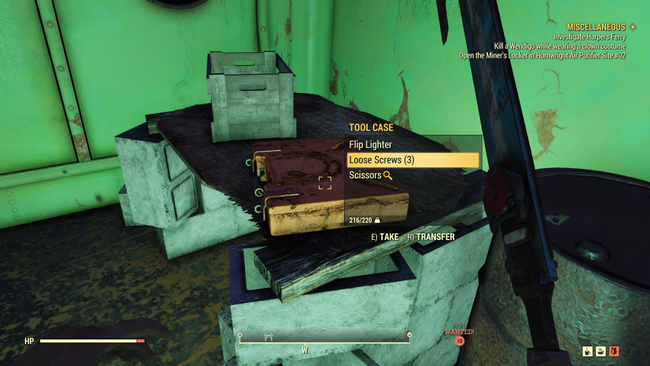Fallout 76 Materials: aluminum, adhesive, lead and other key material locations
Like Fallout 4 before it, Fallout 76 has a heavy emphasis on crafting, even moreso than its predecessor. Not only are the workshop and settlement mechanics carried over from the 2015 title, but weapons and armor crafting have also been overhauled. While weapon and armor crafting existed in Fallout 4, it was only really in the sense to be able to modify weapons with specific enhancements. Not only is this still the case in 76, but durability is also a new factor -- weapons and armor will have a condition status that will need to be monitored, or else you'll risk them breaking on you at the most inopportune times.
Unlike games like Fallout: New Vegas, where repairing weapons and armor was done through a combination of the Repair skill, Weapon Repair Kits, or combining two like items in order to improve their condition, repairs in Fallout 76 will require the same materials as modification and settlement structures. Add into this keeping your ammo stores replenished, and you'll find yourself constantly on the lookout for certain materials. Here's some tips about where to find each.
Check out our Camp Guide if you're looking for some basic survival tips. For those looking to plan their builds ahead of time, take a look at our guide on Perks. We've also got the lowdown on how to launch your first nuke. If you're looking fo what you'll need to craft the game's power armor sets, you can take a look at that process here.
Fallout 76 - Finding the plans for the Tinker's Workbench
While brand new players can craft Weapon and Armor Workbenches on the spot, you won't be able to craft a Tinker's Workbench right away. The Tinker's bench is an analogous crafting station, used primarily to craft ammunition, so it's important to have.
To find plans for the Tinker's Workbench, simply continue on the main quest route through Second Helpings. As a reward for this quest, you'll get plans to craft the Workbench. Just make sure to read any Plans (and Recipes) from the Notes section of your inventory to be able to craft the item. Once you craft one bench, you can hold onto it as a Stored item once your camp moves from place to place.

Fallout 76 - Tagging and Scraping Junk into Materials
When you don't have enough materials to repair or mod a certain item or ammo type, the game will give you an option to tag materials that you are missing for the repair or upgrade, just as in Fallout 4. What this will do is place a magnifying glass icon over any junk items that can be broken down into useful materials. While some of these are semi-obvious, such as Wonderglue breaking down into Adhesive, others are not quite so apparent, such as Scissors breaking down into Plastic.
Whenever you have a certain ammo or armor that requires a certain material type, it's a good idea to keep it tagged to make sure you don't run out -- extras can always go into your Stash if need be.

Fallout 76 Material Locations for Aluminum, Adhesive, Lead and more
We're focusing on some of the most elusive materials for this list -- finding Aluminum is a lot harder than Steel, for instance. We'll add to this list as we progress through and learn what materials become important to hold onto and keep an eye out for.

Adhesive
The two primary sources of adhesive are Duct Tape and Wonderglue, which are both often found in toolboxes and storage sheds. In a pinch, you can also get it from Vegetable Starch, which you can craft at and cooking station using Corn, Tatos, Mutfruit, and Purified water.
Aluminum
Potentially the most sought after material in the game, used in all degrees of repairs, modifications, and ammunition. Aluminum Cans are the obvious sources of the material, but it can also be found in Surigical Trays, Coolant Caps, Sensors and Toy Rocketships. You can find rocketships and all sorts of other toys at areas like the Tyler County Fairgrounds in the western Forest area of Appalachia. You can also harvest Aluminum from the public workshop at the Race Track to the west of Vault 76.
Ballistic Fiber
This material is a rare material used to repair higher level armors and power armors, and is not found in many locations. The best sources for it are in Military Grade Duct Tape and Military Ammo Bags, found in locations like Camp McClintock.
One thing to note is that Ballistic Fiber is only used to repair high-level armors, not to originally craft it. So if you find yourself short on the material, you may want to consider just crafting a new armor piece entirely.
Black Titanium
Black Titanium is used to craft Power Armor pieces like the Excavator set. The easiest way to acquire a lot of Black Titanium is to go to the city of Welch in the southern part of the Ash Heap. From one of the vending stations, you can buy three maps: Miner's Map, Excavator's Map, and Prospector's Map. Reading these maps in your pile of notes will mark three locations on your map. Simply head to these locations and find the pile of debris to be rewarded with Black Titanium among other goodies.
Circuitry
Circuitry is mostly used for CAMP related equipment like turrets and machinery, so while some players may not need a bunch of it, others will. Circuitry is found in several robot parts like Sensor Modules and Circuit Boards, which can be looted from robots like protectrons and the like. You can find several of these enemies at locations like the ATLAS observatory and any of the nuclear silos. It can also be found in Telephones, so keep an eye out for those common items whenever you're in an area with lots of offices.
Lead
Lead is reasonable common, but it is used in most all ballistic ammo, so you might still end up keeping it tagged. Lead can be grabbed from Pencils, Paint Cans, and Makeshift Batteries. Robot type enemies such as Protectrons and Robobrains will also often drop Lead.
Leather
Another semi common material, but it is used in many armor repairs. You'll also not find a lot of leather if you don't kill a lot of animal type enemies such as Mole Rats and Ragstags. The Hides of most wild creatures can be scrapped into Leather, but the material can also be found in Baseballs and Teddy Bears, both of which can be found at the Tyler County Fairgrounds.
Plastic
Another material that's used in a large number of repairs and mods, and one of the first materials you should tag. Plastic can be found in Cigarettes, Toothpaste, several Toys, Globes, several Bottles (such as Anti-Freeze and Coolant), and also several obvious items like Plastic Plates and Trays. There's not really any super secret location of a plastic fortress in the game, as far as we know, so this material just requires knowing what to keep out on the lookout for on various storage shelves and within toolboxes. Morgantown High School is a great farm location for plastic. Grab all the halloween decorations you can.
Screws
Screws are abundant but used in a lot of weapon mods and repairs. They can be found in all sorts of basic equipment, such as Globes and Hot Plates. Oddly enough, we found most of our Screws in Desk Fans and Typewriters, found in many buildings and offices. Keep out on the lookout for these near any terminal.
Springs
Springs are similar to screws in that they are used primarily in weapon crafting and repair. Alarm Clocks and especially Battered Clipboards seem to be the most abundant source of springs. They are also found in Silver Pocketwatches and can be found loose in toolboxes. Clipboards specifically can be found in Sugar Grove in really high numbers -- make sure to check on the shelves and boxes in the last room. They are also relatively common in Camp McClintock within the blue colored crates.
Ultracite
For those that are looking to repair their Ultracite Power Armor, you might not be sure where to find the material. You might earn some as a quest reward from The Motherlode, located at the Hornwright Industrial Headquarters. The more abundant location, however, is the green material located near Fissures.